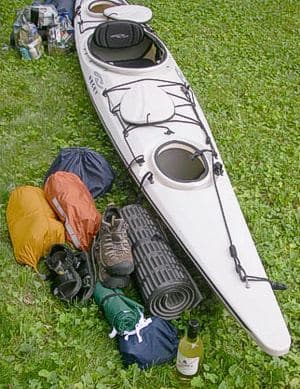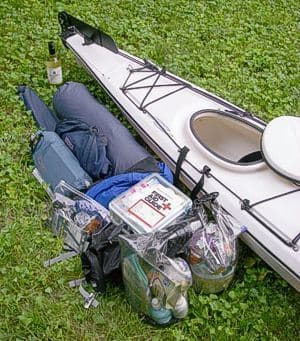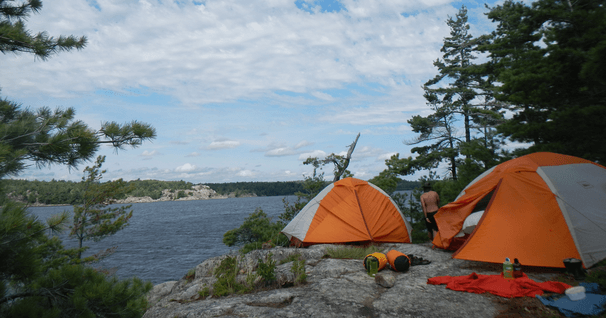Packing a Kayak for Camping
At some point early in our paddling lives, perhaps when we find ourselves approaching the end of a long paddling day but still a few miles from the takeout, we get to wondering. "What if," we surmise, thoughtfully stroking our stubbled chins, "I didn't have to go home? What if I had, right here inside my boat, all the stuff I needed to eat and sleep and be comfortable for a night? Maybe two ...?"
And so the ancient art of paddle-camping is rediscovered. But be careful; it was exactly this sort of fanciful reasoning that caused many a voyageur and mountain man to head for the woods, never to be seen again.
Following are some tips and pointers to help make your own overnight kayak-camping adventures a bit more enjoyable.

Pack Light
If you've recently made the transition from car camping, you may wonder where in your kayak to stow the cast-iron Dutch oven, chaise lounge, and beer cooler. Kayak camping is not as restrictive as backpacking, but almost. Even much of your favorite gear that is easily swallowed by a canoe will have to be left behind when kayak camping, so some strict discipline is in order.
TAHE 10'6 & 11'6 SUP-YAK Inflatables
2-in-1 Kayak & Paddle Board complete packages for single or tandem use.
Size Matters
You'll probably find it easier to use lots of smaller drybags instead of a few larger bags, to better adapt to the oddly-shaped interior of most kayaks. Your bags should be color coded for organization, and perhaps even labeled with identifying tags. Heavy vinyl bags are alright for food, as they are more resistant to puncture and probably allow less bear-attracting odor to waft through the woods, but they stubbornly stick to one another when packing into the boat. Most of my favorite bags are instead made of lightweight nylon or polyester fabric with an internal rubberized waterproof coating. Though perhaps requiring a bit more care to prevent punctures, these bags easily slide past one another when jammed into a cargo compartment, making packing more efficient. As you close each drybag, be sure to squeeze out as much air as possible before rolling down the neck seal, to conserve precious space inside your compartments.
Keep Your Balance
Heavier items like food and water should be packed near the middle of your kayak, preferably just behind the rear bulkhead, while lighter, bulky items like sleeping bags and clothing get packed toward the ends. Everything should be packed low and centered from side-to-side, to keep your boat stable and balanced. The only exception to these general rules is if you need to re-trim a boat for better handling. When one of my paddling partner's skeg cable broke halfway through a trip, he wisely loaded his boat a little stern-heavy the following days, to alleviate weathercocking.

A few days before your first overnighter, try test-packing your kayak to see if all your intended gear will indeed fit. It probably won't. As you choose items that won't make the trip, just remind yourself that the whole purpose of kayak camping is to get away from it all.
On my website, SuperiorPaddling.com, I offer my current personal packing list, suitable for multi-day, self-supported sea-kayak trips on the Great Lakes or inland waterways. I am constantly tinkering with this list (as evidenced by the revision number), and post new ones as they evolve. You can view my current packing list here.
Jeffrey Lee edits Superior Paddling, a kayaking website that seeks to inform, inspire, and compel sea-kayakers to explore and appreciate the endless possibilities of paddling and kayak-touring in the upper Great Lakes region. He considers himself an "enthusiastic student" of the art of sea kayaking.
Related Articles
One of the most regarded luxuries of a kayak is its use as a means of "escape", a chance to ply quiet…
Kayak camping is not all that different than backpacking - if anything it is easier as you don't have to…



